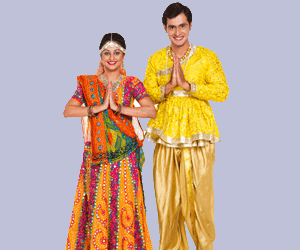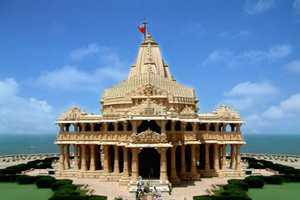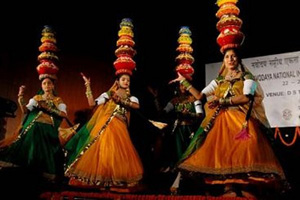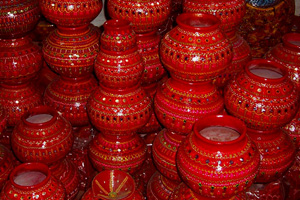Culture of Gujarat
The Gujarati's are known for their diverse cultural heritage and rich traditions. It is a vibrant mix of Hinduism, Islam, Jainism and Buddhism and also a blend of different cultures of the Guajarati's like arts, beliefs, customs, traditions, institutions, inventions, language, technology and values. The culture of the people does not stop with one particular generation but instead the elders of the community see to that the future generations also practice it which automatically leads to the wisdom and appreciation of cultural traditions and lifestyles. They also as a part of their culture join hands to greet the guests and the elders. The lifestyle of the people of Gujarat is very balanced because of the fact that they have a perfect system of learning, religious practices and excellent forms of artistic expressions. The culture of the Gujarati's does not only prevails in Gujarat but it has been widespread to different parts of the world and now recognized as an international culture. There is not much of culture shock seen in the people of Gujarat and so it makes people bold and courageous with lot of energy to face different challenges raised by the globalscenario.
The cultural elements of Gujarat are below:
Mostly Gujarathifood is vegetarian because the state is dominated by Jains and the Vaishnavas. Most of their staple food includes wheat and millet varieties like jowar and bajri. No meal of Gujarathi will miss roti along with a variety of vegetable curries and dishes. The food is generally served on a metal tray which is called as thali and 4-5 small bowls placed on it. These thali mainly consists of roti, dal or kadhi, sabzi also known as shaak and rice. The Gujarathi's are noted for their sweet tongue and every meal will be accompanied by a sweet dish. Sugar is also sometimes alternated by jaggery. Some of the other common food which is a must for the Gujarathi's in their thali are dal, steamed vegetables, homemade pickles, buttermilk and salad. Vaghaar is a blend ofspices, which is purified in hot oil and then added to the dal. Gujarathis generally use lot ofsalt, sugar, tomato and lemon in their cuisine. Desserts, which were in the ancient times offered only on festivity or some special occasions, have now found their way in the daily meals. Ghee is a must in the food of Gujarathi's.Srikhand is a rich dessert made with curds and spiced with saffron, cardamom, nuts, and fruit. The Gujarathis evening snack include 'bhakri-shak' or khichdi kadhi. |
 |
Like any other culture of the country, Gujarathis also adorn themselves with mangalsutras, necklaces, nose rings, earrings, bangles and rings, toe rings and bracelets. It is a must among the married women of Gujarat to wear a red bindi which may be either powder or sticker on their forehead. Also married women stretch the red powder, called 'sindoor', in a short straight line on the scalp, starting near the hairline and cover the area where the hair is generally parted. The most common traditional outfit for the Gujarathi ladies especially at times of occasions are saris which are draped in such a way that the pallu comes over the front of their right shoulder and across the chest tucked into the waist.Salwar Kamiz is also in vogue among married and old women.Traditional attire of the males of Gujarat are dhotis and a kurta is worn on top. The traditional outfits of ladies are chania choli and of men it is called as kedia dress. . |
 |
Although Gujarati is the mother tongue of the natives of Gujarat, many other languages are widely spoken throughout the state. Gujarati is an Indo-Aryan language derived from Sanskrit and is the 26th most widely used language in the world. Gujarati has about 11 different dialects, spoken in various parts of the state. Since the state of Gujarat shares its border with Maharashtra, Madhya Pradesh and Rajasthan; a small section of its population speak the native languages of the neighbouring states, namely Marwari, Marathi, Hindi along with Urdu and Sindhi. The natives of Kutch-a semi-arid region in Gujarat-speaks Kachchi language, which is quite an important language of the area. |
 |
The folk music of Gujarat is known as Sugam Sangeet and has acclaimed world-wide fame. The range of musical instruments utilized in Gujarati folk music includes turi, manjira, ektaro, jantar, zanz pot drum, prabhati, dhol and ravan hattho. Bhajans are also incorporated in their folk songs. Bardic tradition is another major type of folk Gujarati music.
|
 |
The fairs and festivals of Gujarat showcase the real vibrancy and colours of its diverse culture. Thousands of people flock to Gujarat to witness the extravaganza during festivals like Navratri Mahotsav, Deepawali, Rathyatra and Kite festival. There are some fairs as well that are organized in the state every year, namely- Shamlaji Melo, Bhadra Purnima Fair, and Mahadev Fair. These occasions lure visitors from all across the globe and increase the tourist footfall. The Rann Utsav is a major festival and witnesses an exquisite carnival of music, dance and natural beauty. |
 |
The people of Himachal Pradesh are known for their wooden crafts because the region has abundance of trees like Pine, Cedrus deodar, walnut, horse chestnut and wild black mulberry which are used for craft work and carvings of doors, windows, balcony panels, etc.They are also known for metal craft. Antique metalstatuettes are one of the most significant aspects in many temples of Himachal Pradesh. The statues of gods and goddesses also appear as mohras or in metal plaques. Household utensils are made using brass which is very famous. They are also involved in making things from bamboo items like boxes, sofas, chairs, baskets and rack. Pashmina shawl and the colourful Himalayan caps are in demand in overseas |
 |

